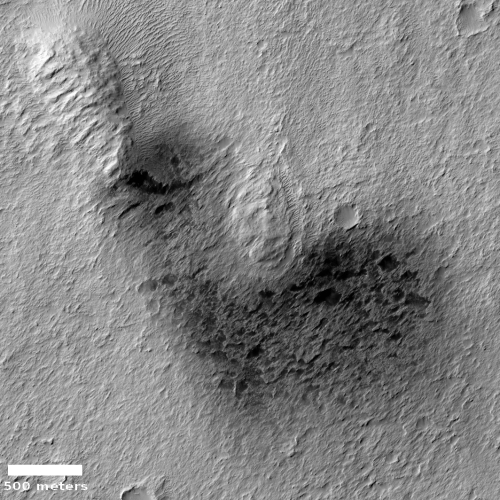Wind-blown dark material on Mars
Cool image time! The photo to the right, cropped and reduced to post here, was taken on May 13, 2021 by the high resolution camera on Mars Reconnaissance Orbiter (MRO). It shows a cluster of small depressions from which has blown dark material across the ground to the south. The full image also shows two craters north and south of this cluster that have similar dark material blown from their interiors.
When I first looked at this image, I wondered if the dark material and these depressions signaled a recently active volcanic vent where magma had spewed upward to stain the nearby ground. See for example this recent post about what some scientists believe might the most recent volcanic event so far found on Mars. I emailed several scientists for their thoughts, all of whom said this appears to not be active volcanism but merely windblown dark material.
Kim Seelos, science operations lead for MRO’s visible-near infrared spectrometer, put it simply. “My own reading of this image is that the dark areas here are likely akin to wind streaks.” Instead of the dark material being thrown from the depressions by a volcanic event, it was swept to the south by the prevailing winds.
How that dark material got into the depressions, and why it was so comparably darker than the surrounding terrain, remains unclear. David Horvath of the Planetary Science Institute in Arizona speculated that the low hills just north of the dark patch might be a factor.
» Read more
Cool image time! The photo to the right, cropped and reduced to post here, was taken on May 13, 2021 by the high resolution camera on Mars Reconnaissance Orbiter (MRO). It shows a cluster of small depressions from which has blown dark material across the ground to the south. The full image also shows two craters north and south of this cluster that have similar dark material blown from their interiors.
When I first looked at this image, I wondered if the dark material and these depressions signaled a recently active volcanic vent where magma had spewed upward to stain the nearby ground. See for example this recent post about what some scientists believe might the most recent volcanic event so far found on Mars. I emailed several scientists for their thoughts, all of whom said this appears to not be active volcanism but merely windblown dark material.
Kim Seelos, science operations lead for MRO’s visible-near infrared spectrometer, put it simply. “My own reading of this image is that the dark areas here are likely akin to wind streaks.” Instead of the dark material being thrown from the depressions by a volcanic event, it was swept to the south by the prevailing winds.
How that dark material got into the depressions, and why it was so comparably darker than the surrounding terrain, remains unclear. David Horvath of the Planetary Science Institute in Arizona speculated that the low hills just north of the dark patch might be a factor.
» Read more

